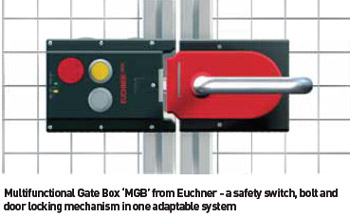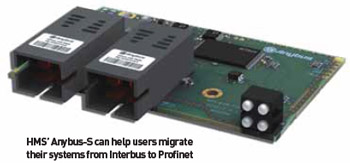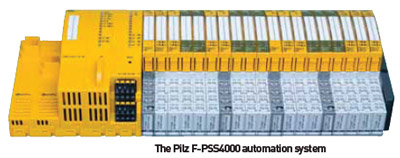Over the last 20 years, SPS/IPC/DRIVES has become firmly established as the exhibition and conference for electric automation technology. This year's event, held at Messe Frankfurt from November 24-26, 209, will be covering all components, from basic system platforms to integrated automation solutions. It gives a ‘system first’ view of automation technologies that are or could be used in automotive manufacturing applications.
In tune with the times, key topics for the 2009 exhibition and accompanying conference include energy efficiency, industrial identification and safety and security. In addition to the formal conference, panel discussions will be held at different forums in the exhibition halls. The following is a round-up of what some major exhibitors will be featuring at the SPS/IPC/DRIVES event.

 Euchner is highlighting its Multifunctional Gate Box or ‘MGB’ at the SPS/IPC/DRIVES event. A combined safety switch, bolt and door locking mechanism, from door handle to the integrated guard lock monitoring, the MGB combines all the necessary features required to protect a safety door in accordance with EN ISO 13849 and EN 1088.
Euchner is highlighting its Multifunctional Gate Box or ‘MGB’ at the SPS/IPC/DRIVES event. A combined safety switch, bolt and door locking mechanism, from door handle to the integrated guard lock monitoring, the MGB combines all the necessary features required to protect a safety door in accordance with EN ISO 13849 and EN 1088.
At the core of this modular system is the evaluation module, available with and without guard locking. In combination with a handle module and an optional escape release, the MGB is designed to protect virtually any safety door. The evaluation module is also available with integrated controls and indicators to enable operation mode selection and many other functions. As a result, the safety system becomes a small operator panel.
HMS Industrial Networks, Hall 6, Stand 222
 HMS Industrial Networks has extended its Profinet product range with the introduction of its Anybus-S Profinet-IRT interface with fibre optic connectors.
HMS Industrial Networks has extended its Profinet product range with the introduction of its Anybus-S Profinet-IRT interface with fibre optic connectors.
The embedded communication module, Anybus-S for Profinet, combines a Profinet interface with IRT functions, according to the Class C standard. The intelligent communication module is based on the ERTEC-200 technology from Siemens and includes all analogue and digital components for an effective Profinet IO interface with IRT features, including an integrated two-port real-time switch. The physical network connection is made via two SC-RJ fiber optic connectors.
This module is specifically targeted for use within the automotive industry. Many automobile manufacturers using fibre optic technology in their existing Interbus installations are now migrating to Profinet with fibre optic transmission, with Profinet seen as a natural evolution from Interbus.
 For economic and ecological reasons, the intelligent use of power is more important than ever. In order to provide greater transparency as to power usage in buildings, production plants or subareas, Moeller has introduced its new range of MCx measuring and communication modules for compact circuit-breakers and switch-disconnectors up to 630A.
For economic and ecological reasons, the intelligent use of power is more important than ever. In order to provide greater transparency as to power usage in buildings, production plants or subareas, Moeller has introduced its new range of MCx measuring and communication modules for compact circuit-breakers and switch-disconnectors up to 630A.
The MCx modules provide all the relevant measuring data for calculating power consumption: Phase and N conductor currents, rms voltages, active, reactive and apparent power, as well as power factor (cos phi). The modules are designed for a voltage range of 35-690V, a current range of 1.5-630A and a frequency range of 50-60Hz. The accuracy class is 1.5 and is therefore sufficiently accurate for corporate cost calculations.
The MCx range includes a display device (96 x 96mm) with IP54 protection and a keypad for front mounting on a switch cabinet door. Individual datasets can be selected via the keypad and the measuring results displayed on the device. The data connection to the MCx module is a serial connection via a two-wire cable.
Control architectures with incorporated safety systems will be taking a prominent place in this year’s SPS/IPC/DRIVES, with companies such as Pilz showing integrated solutions such as its PSS4000 automation system.
This system is designed for all machine control and safety technology functions, including motion control, diagnostics and visualization. The aim is to simplify the decentralization of control functionalities and reduce engineering work.
 The PAS4000 (Pilz Automation Suite) software platform plays a key role in this, enabling users to retain a centralized perspective of decentralised, distributed control structures.
The PAS4000 (Pilz Automation Suite) software platform plays a key role in this, enabling users to retain a centralized perspective of decentralised, distributed control structures.
PSS4000 is designed to reduce the increasing complexity this would normally involve, removing interface problems associated with the connection of multiple control systems.
As a result, decentralization can help achieve a higher level of reusability and increase the level of standardization – when identical control programs and subfunctions are used.
This in turn allows machine elements to have a modular structure, so that identical components can be reused with minimum effort. The benefits can be seen in greater availability, due to local error reactions, and higher productivity as a result of shorter reaction times across the whole system.
The tools used on the PAS4000 software platform, controlling all programming and parameter setting functions, are fully compatible with standard data and user interfaces. Not only does this make it easier to start working with or upgrade to PAS4000, it also means that multiple entries can be avoided, minimizing the error sources which are often associated with manual data entry. PAS4000 offers established programming languages in accordance with IEC61131-3.
Schneider Electric, Hall 4, Stand 310
The need to increase business turnover in the current market presents OEMs with a series of challenges, yet many will comment that there is no ‘quick fix’. That said, improving equipment efficiency can shorten time-to-market expectations by as much as 50%, translating to a reduction in machine operating costs, with the added bonus of reducing company overheads.
With this in mind, Schneider Electric is introducing MachineStruxure at SPS/IPC/DRIVES, a unique machine building solution that is designed to reduce machine design times. Based upon tested, validated and innovative architectures, MachineStruxure incorporates flexible and scalable hardware platforms and a comprehensive single software suite with application function block libraries.


































